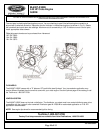
M-6007-X302E
340 HP Crate Engine
GUIDE
NO PART OF THIS DOCUMENT MAY BE REPRODUCED WITHOUT PRIOR AGREEMENT AND WRITTEN PERMISSION OF
FORD RACING PERFORMANCE PARTS.
IS-1850-0182
Page 3 of 13
Techline 1-800-367-3788
Factory Ford shop manuals are available from Helm Publications, 1-800-782-4356
IGNITION SYSTEM CONSIDERATIONS/COMMON PROBLEMS
The ignition system must deliver a properly timed spark. There are a lot of factors that determine when the spark
should be delivered. The most common factors include: compression ratio, fuel quality, fuel octane rating,
combustion chamber design, engine operating temperature, power adders such as NOS or supercharger, inlet air
temp, altitude, and load.
• Avoid too much or too little timing for your engine combination.
• Avoid hooking up the vacuum advance to intake manifold vacuum instead of ported vacuum.
• Avoid inductive crossfire created by improper plug wire routing. Separate plug wires on cylinders that fire
in sequence.
• Improper timing can damage pistons, rod bearings, head gaskets, and many other engine parts.
• Typical total mechanical advance timing at 4000 rpm for Ford Racing Performance Parts crate engines:
5.0L - 36° to 38° With factory EFI, 14 to 16 degrees initial.
FUEL DELIVERY CONSIDERATIONS
Size of fuel pump, size of fuel line, fuel pump placement, fuel filter placement, fuel filter size, injector size, fuel rail size,
fuel pressure, jet size, and baffling in the fuel tank.
Does the fuel system maintain full pressure at peak engine horsepower in high gear? Altitude, air temperature, and
fuel characteristics including quality, specific gravity, and octane rating, will affect your jetting requirements. Engine
efficiency and Brake Specific Fuel Consumption (BSFC) also have an effect. Here are some examples of a Holley
750 CFM 4V.
Jetting Jetting
Octane Temp. Elevation Front Rear
94 80 F Sea level 81 86
Aviation 100LL 80 F Sea level 81 84
110 Race 80 F Sea level 78 83
94 80 F 3000 ft. 76 81
94 80 F 6000 ft. 73 77
94 40 F Sea level 84 89
94 120 F Sea level 78 83
As you can see by these examples, jet requirements can vary a lot depending on fuel, altitude, and temperature.
Oxygenated fuels are available in some states and can dramatically affect your jetting requirements. Make sure you
get your jetting correct.















